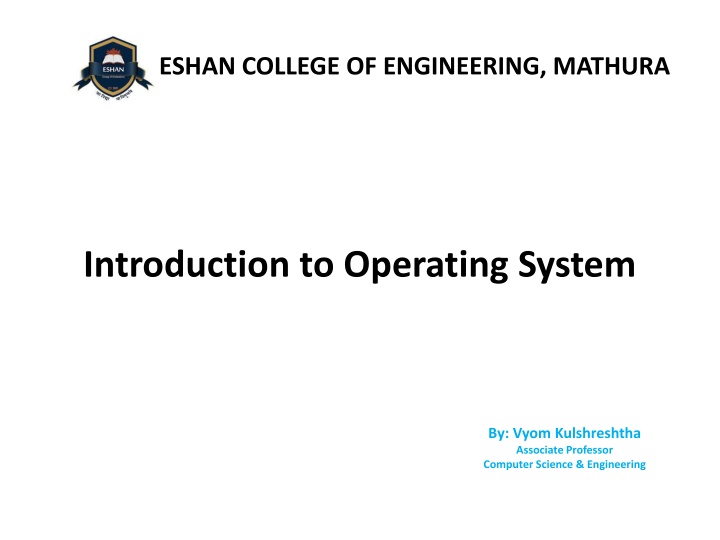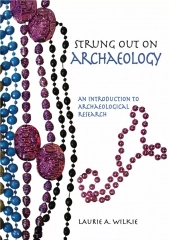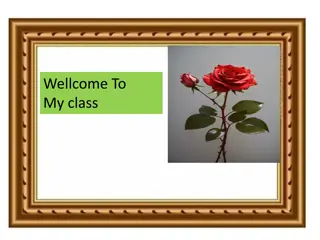
Understanding Operating Systems: Eshan College Insights
Dive into the fundamentals of operating systems with insights from Eshan College of Engineering, Mathura. Explore the components of a computer system, the role of an operating system, and the diverse needs of users in different computing environments. Delve into how operating systems vary based on user requirements and system resources.
Download Presentation

Please find below an Image/Link to download the presentation.
The content on the website is provided AS IS for your information and personal use only. It may not be sold, licensed, or shared on other websites without obtaining consent from the author. If you encounter any issues during the download, it is possible that the publisher has removed the file from their server.
You are allowed to download the files provided on this website for personal or commercial use, subject to the condition that they are used lawfully. All files are the property of their respective owners.
The content on the website is provided AS IS for your information and personal use only. It may not be sold, licensed, or shared on other websites without obtaining consent from the author.
E N D
Presentation Transcript
ESHAN COLLEGE OF ENGINEERING, MATHURA Introduction to Operating System By: Vyom Kulshreshtha Associate Professor Computer Science & Engineering
ESHAN COLLEGE OF ENGINEERING, MATHURA What is an Operating System? A program that acts as an intermediary between a user of a computer and the computer hardware Operating system goals: Execute user programs and make solving user problems easier Make the computer system convenient to use Use the computer hardware in an efficient manner By: Vyom Kulshreshtha Associate Professor Computer Science & Engineering
ESHAN COLLEGE OF ENGINEERING, MATHURA Computer System Structure Computer system can be divided into four components: Hardware provides basic computing resources CPU, memory, I/O devices Operating system Controls and coordinates use of hardware among various applications and users Application programs define the ways in which the system resources are used to solve the computing problems of the users Word processors, compilers, web browsers, database systems, video games Users People, machines, other computers By: Vyom Kulshreshtha Associate Professor Computer Science & Engineering
ESHAN COLLEGE OF ENGINEERING, MATHURA Four Components of a Computer System By: Vyom Kulshreshtha Associate Professor Computer Science & Engineering
ESHAN COLLEGE OF ENGINEERING, MATHURA What Operating Systems Do Depends on the point of view Users want convenience, easeofuse and good performance Don t care about resourceutilization But shared computer such as mainframe or minicomputer must keep all users happy Users of dedicate systems such as workstations have dedicated resources but frequently use shared resources from servers Handheld computers are resource poor, optimized for usability and battery life Some computers have little or no user interface, such as embedded computers in devices and automobiles By: Vyom Kulshreshtha Associate Professor Computer Science & Engineering
ESHAN COLLEGE OF ENGINEERING, MATHURA Operating System Definition OS is a resource allocator Manages all resources Decides between conflicting requests for efficient and fair resource use OS is a control program Controls execution of programs to prevent errors and improper use of the computer By: Vyom Kulshreshtha Associate Professor Computer Science & Engineering
ESHAN COLLEGE OF ENGINEERING, MATHURA Operating System Definition (Cont.) No universally accepted definition Everything a vendor ships when you order an operating system is a good approximation But varies wildly The one program running at all times on the computer is the kernel. Everything else is either a system program (ships with the operating system) , or an application program. By: Vyom Kulshreshtha Associate Professor Computer Science & Engineering
ESHAN COLLEGE OF ENGINEERING, MATHURA Computer Startup BIOS performs POST bootstrap program is loaded at power-up or reboot Typically stored in ROM or EPROM, generally known as firmware Initializes all aspects of system Loads operating system kernel and starts execution By: Vyom Kulshreshtha Associate Professor Computer Science & Engineering
ESHAN COLLEGE OF ENGINEERING, MATHURA Computer System Organization Computer-system operation One or more CPUs, device controllers connect through common bus providing access to shared memory Concurrent execution of CPUs and devices competing for memory cycles By: Vyom Kulshreshtha Associate Professor Computer Science & Engineering
ESHAN COLLEGE OF ENGINEERING, MATHURA Computer-System Operation I/O devices and the CPU can execute concurrently Each device controller is in charge of a particular device type Each device controller has a local buffer CPU moves data from/to main memory to/from local buffers I/O is from the device to local buffer of controller Device controller informs CPU that it has finished its operation by causing an interrupt By: Vyom Kulshreshtha Associate Professor Computer Science & Engineering





